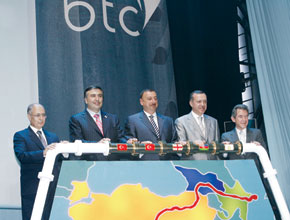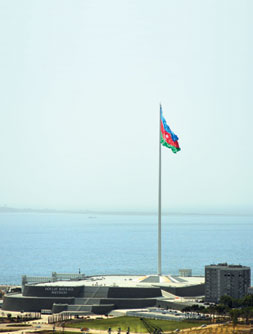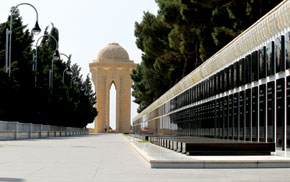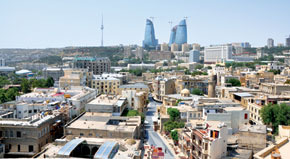Pages 8-12
by Ibrahim Zeynalov
Azerbaijan celebrated the twentieth anniversary of the restoration of state independence on 18 October 2011. The land has evidence of being one of the world’s most ancient human dwellings and centres of culture and the most ancient traditions of statehood, doing back some 5,000 years. States existing on the territory of Azerbaijan invariably made their military-political and economic-cultural influence felt in the Near and Middle East.
The preservation of independence played a crucial role in developing a culture of public administration in Azerbaijan as well as a socio-economic, cultural, ethnic and political history, in the process of developing a united nation. Different states existed on the territory of Azerbaijan (Manna, Atropatena, Albania and others) at different periods; all spheres of economic and cultural life developed, along with traditions of statehood.
The Azerbaijan Democratic Republic
The largest empires in history, even the terrifying Russian colonizers, ultimately failed to destroy the traditions of statehood and desire for independence among the Azerbaijani people. The struggle for freedom and independence in the 20th century was very difficult, complicated and uneven. On 28 May 1918, independence was won and the colonial regime of tsarist Russia was ended. However, preserving this independence, achieved at such great cost, proved to be impossible.
The Caucasus Front Command and the Volga Caspian Fleet were ordered by the Red Army to enter Azerbaijan on 27 April 1920, moving from Yalama to capture Baku within 5 days. On 23 April, Mikhail Tukhachevsky, commander of the Caucasian front and Sergo Ordzhonikidze, a member of the Revoluti onary Military Council, ordered the 11th Army not only to seize Baku province but to occupy the whole of the country. Thus, the 11th Bolshevik Red Army entered Baku on 28 April 1920 and put an end to the independent Azerbaijan Democrati c Republic. Azerbaijan was occupied anew by (this ti me Soviet) Russians.
Azerbaijan was still formally independent from 28 April 1920, but even this was lost in 1922 with the creation of the USSR, when the Soviet Socialist Republic of Azerbaijan was established. This state existed under the banner of the October Revolution from 1922 to 18 October 1991.
The 1960s saw the Republic’s economy undergoing a deep crisis before Heydar Aliyev rose to leadership on 14 July 1969. From his positi on on the central committee of the Communist Party he drove through a policy of systematic development to revive the economy. From 1969-1982 more than 250 plants, factories and other production enterprises were put into operation and 630,000 new jobs were created.
The USSR’s destructive legacy
However, by the late 1980s the USSR leadership understood the Union’s weakness and the threat from republics desiring to restore their lost independence. They began to implement measures to weaken the republics’ economic, cultural and spiritual potential, especially that of the Turkic republics. The Soviet Union attempted to hold off inevitable failure by adopting ‘Perestroika’ (restructuring) and ‘Glasnost’ (openness) and creating nationalist confrontations in the regions.
The Soviet leadership tried to distract att en- ti on from the nati onal liberation movement for independence by creating a centre of conflict in the Nagorno-Karabakh region of Azerbaijan. The outbreak of Armenian aggression against Azerbaijan in 1988 was a result of the deliberate policy directed against the independence movement.
In January 1988 the last stage of the ethnic cleansing of Azerbaijanis from Armenia began and was completed with the emptying of Nuvadi village (Mehri region) of the Soviet Socialist Republic of Armenia on 8 August 1991. As a result, 230,000 Azerbaijanis were driven out of 185 villages in the Armenian SSR.
Thus, the Nagorno-Karabakh confl ict, directed against Azerbaijani independence, was initiated. From the late 1980s, the threat from the growing nati onal movement for independence was of increasing concern to the Soviet leadership. On the night of 19/20 January 1990, Moscow committed a bloody massacre in Baku in order to suppress the national-liberation movement and serve as a lesson to other national republics. 131 people were killed, 744 people were injured, 400 people were arrested and 4 people went missing in Baku and other regions. Liberty and independence require sacrifice; the Azerbaijani struggle became even more acute and, along with those in other republics, contributed to the inevitable collapse of the USSR, the dissolution of the Communist Party and, consequently, to the independence of each of the union’s republics.
Independent again
A new era in the country’s history - one of independent development - opened with the adoption of the Constitutional Act ‘On the State Independence of Azerbaijan’ on 18 October 1991. The USSR’s disappearance from the political map aft er its collapse on 8 December 1991 led to the recognition of the national republics, as well as opening the way to the development of the declaration of independence. The Constitutional Act was put to a nation-wide referendum on 29 December 1991. The national, sovereign state and independence of Azerbaijan was legally approved and put into effect.
History has proved many times that protecting a nation’s independence is much more difficult and complicated than winning it. The Azerbaijani people, who twice achieved independence in the 20th century, only maintained the first one for 23 months. The 20th anniversary of its restoration, on 18 October 1991, was celebrated in October this year.
Since the restoration, state-strengthening measures have been taken to ensure economic and social security, the building of a democratic, legal and secular state and the country’s integration into the global community. The national anthem (May 1992), and the state flag and emblem were approved in early 1993. In 1992, the national currency - the manat - was put into circulation. Looking back at the past 20 years, four stages may be identified in the development of independence. The first stage covered the period from 1991 to 1993, the second stage from 1993 to 1995, stage three lasted from 1995 to 2003, and the fourth stage has been in process since 2003.
The first stage, from 1991 to 1993, was one of struggle for survival in the chaotic aftermath of the USSR’s collapse and in the face of increasing aggression from Armenia against Azerbaijan.
Determined leadership
The second stage of renewed independence began with the return to power of Heydar Aliyev in June 1993. The power vacuum existing then was filled, separatist forces and criminal elements encroaching upon the Azerbaijani state, its independence and territorial integrity were neutralized, the threat of civil war was overcome and state unity was solidi- fied. The formation of national armed forces, and the measures taken to defend Azerbaijani lands, improved the military situation. A cease- fire was signed by Armenia and Azerbaijan in May 1994, to begin the process of a peaceful settlement of the Nagorno-Karabakh problem. These steps all helped to consolidate independence and promote greater confidence and interest from other countries.
 Official inauguration of the BTC pipeline. From the left: Ahmet Necdat Sezar (President of Turkey), Mikhail Saakashvili (President of Georgia), Ilham Aliyev (President of Azerbaijan), Recab Tayip Erdogan (Prime Minster of Turkey), John Browne (BP Group CEO)
Official inauguration of the BTC pipeline. From the left: Ahmet Necdat Sezar (President of Turkey), Mikhail Saakashvili (President of Georgia), Ilham Aliyev (President of Azerbaijan), Recab Tayip Erdogan (Prime Minster of Turkey), John Browne (BP Group CEO)
On 20 September 1994, the first oil contract, hailed the ‘Contract of the Century’, was signed. This facilitated Azerbaijan’s oil strategy and ensured the successful implementation of large-scale projects in the Caspian basin. The Baku-Tbilisi-Ceyhan oil pipeline and the Baku- Tbilisi-Erzurum gas pipeline were put into operation in 2006 and in 2007 respectively. The ‘Contract of the Century’, concluded with leading international oil companies, was an important step towards Azerbaijani integra- tion into the world economy.
The income earned from oil contracts created the conditions for fundamental change in every sphere of life, including the implementation of socio-economic reforms. These developments and strengthening independence worried those opposed to such progress and, in October 1994 and March 1995 there were two attempts at a coup état. They failed to achieve public support and were thwarted by a determined leadership.
From contract to constitution
From 1995, our independence entered a qualitatively different stage. On 12 November of that year, the first constitution of the independent state was adopted. The first parliamentary elections were held and the first parliament of the independent state was formed. This constitution established a legal basis for the state and the development of a model for society.
The third and most productive period of our independence covers the years from 1996 to 2003. The establishment of a secure state provided macro-economic stability in the republic. Production began to rise from 1996 and a new economic system suitable for the formation of a democratic state was initiated. A legal basis for the formation of a market economy in Azerbaijan was established. There was legislation on land and agrarian reform, privatisation, business development, and tax, financial and banking systems were adopted. Privatisation was key to these reforms and was accelerated. The transition to a market economy and development of entrepreneurship reversed the stagnation which had long afflicted the economy. Industrial production increased, especially in the oil, gas, petrochemical, metallurgy, engineering and food industries. All these served to strengthen our independence.
There was a special focus on attracting foreign investment to Azerbaijan. The inflow of foreign capital intensified following the ‘Contract of the Century’. Foreign investment per head is now the highest in the Commonwealth of Independent States.
The establishment of international economic relations, the strengthening of state independence and achieving a resolution of the Nagorno- Karabakh problem were the main thrusts of the country’s foreign policy at this stage.
On the world stage
Azerbaijan has joined a number of international organizations: the Organization of the Islamic Conference (1991), the Economic Cooperation Organization (1992), the Agreement for Security and Cooperation in Europe (now OSCE), and the United Nations Organization. Joining the NATO Partnership for Peace programme in 1994 and the OSCE’s 1996 Lisbon Summit decision on settling the Nagorno- Karabakh conflict and supporting the territorial integrity of Azerbaijan, were notable successes for its foreign policy.
On 8 September 1998, a conference was held in Baku on the restoration of the historic Silk Road; attended by 32 countries and 13 international organizations, it ended with the signing of a multilateral agreement to develop an international transport network along the Europe-Caucasus-Asia corridor. In 1999, an agreement was signed in Istanbul to build the Baku-Ceyhan main export oil pipeline. The 1st Convention of World Azerbaijanis was held in Baku in November 2001, followed in 2006 and 2011 by the 2nd and 3rd conventions, which were important contributions by Azerbaijanis around the globe to the strengthening of state independence.
On 17 January 2001, Azerbaijan acquired full membership of the Council of Europe. Eight days later the country’s flag was raised in front of the Council of Europe headquarters in Strasbourg. On 24 September a document confirming Azerbaijan`s territorial integrity was adopted at the autumn session of the Parliamentary Assembly of Council of Europe (PACE).
The fourth stage of our renewed independence began in 2003; social, political and economic development underpins the state’s consolidation. Of course, this is all within the context of the continuing Armenian-Azerbaijani, Nagorno-Karabakh conflict, begun in 1988 and still unresolved. Numerous meetings and the activity of the Minsk Group of OSCE have not yet yielded results. A settlement to preserve territorial integrity is crucial to our independence.
The twenty-year history of renewed independence has led to today’s secular, democratic state in Azerbaijan. The independence of their state is vital to every citizen of the country.
About the author: Ibrahim Zeynalov is a Doctor of Historical Science and Professor of Azerbaijani history at Baku State University. He is the author of monographs and articles on modern Azerbaijani history.
by Ibrahim Zeynalov
Azerbaijan celebrated the twentieth anniversary of the restoration of state independence on 18 October 2011. The land has evidence of being one of the world’s most ancient human dwellings and centres of culture and the most ancient traditions of statehood, doing back some 5,000 years. States existing on the territory of Azerbaijan invariably made their military-political and economic-cultural influence felt in the Near and Middle East.
The preservation of independence played a crucial role in developing a culture of public administration in Azerbaijan as well as a socio-economic, cultural, ethnic and political history, in the process of developing a united nation. Different states existed on the territory of Azerbaijan (Manna, Atropatena, Albania and others) at different periods; all spheres of economic and cultural life developed, along with traditions of statehood.
The Azerbaijan Democratic Republic
The largest empires in history, even the terrifying Russian colonizers, ultimately failed to destroy the traditions of statehood and desire for independence among the Azerbaijani people. The struggle for freedom and independence in the 20th century was very difficult, complicated and uneven. On 28 May 1918, independence was won and the colonial regime of tsarist Russia was ended. However, preserving this independence, achieved at such great cost, proved to be impossible.
The Caucasus Front Command and the Volga Caspian Fleet were ordered by the Red Army to enter Azerbaijan on 27 April 1920, moving from Yalama to capture Baku within 5 days. On 23 April, Mikhail Tukhachevsky, commander of the Caucasian front and Sergo Ordzhonikidze, a member of the Revoluti onary Military Council, ordered the 11th Army not only to seize Baku province but to occupy the whole of the country. Thus, the 11th Bolshevik Red Army entered Baku on 28 April 1920 and put an end to the independent Azerbaijan Democrati c Republic. Azerbaijan was occupied anew by (this ti me Soviet) Russians.
Azerbaijan was still formally independent from 28 April 1920, but even this was lost in 1922 with the creation of the USSR, when the Soviet Socialist Republic of Azerbaijan was established. This state existed under the banner of the October Revolution from 1922 to 18 October 1991.
The 1960s saw the Republic’s economy undergoing a deep crisis before Heydar Aliyev rose to leadership on 14 July 1969. From his positi on on the central committee of the Communist Party he drove through a policy of systematic development to revive the economy. From 1969-1982 more than 250 plants, factories and other production enterprises were put into operation and 630,000 new jobs were created.
The USSR’s destructive legacy
However, by the late 1980s the USSR leadership understood the Union’s weakness and the threat from republics desiring to restore their lost independence. They began to implement measures to weaken the republics’ economic, cultural and spiritual potential, especially that of the Turkic republics. The Soviet Union attempted to hold off inevitable failure by adopting ‘Perestroika’ (restructuring) and ‘Glasnost’ (openness) and creating nationalist confrontations in the regions.
The Soviet leadership tried to distract att en- ti on from the nati onal liberation movement for independence by creating a centre of conflict in the Nagorno-Karabakh region of Azerbaijan. The outbreak of Armenian aggression against Azerbaijan in 1988 was a result of the deliberate policy directed against the independence movement.
In January 1988 the last stage of the ethnic cleansing of Azerbaijanis from Armenia began and was completed with the emptying of Nuvadi village (Mehri region) of the Soviet Socialist Republic of Armenia on 8 August 1991. As a result, 230,000 Azerbaijanis were driven out of 185 villages in the Armenian SSR.
Thus, the Nagorno-Karabakh confl ict, directed against Azerbaijani independence, was initiated. From the late 1980s, the threat from the growing nati onal movement for independence was of increasing concern to the Soviet leadership. On the night of 19/20 January 1990, Moscow committed a bloody massacre in Baku in order to suppress the national-liberation movement and serve as a lesson to other national republics. 131 people were killed, 744 people were injured, 400 people were arrested and 4 people went missing in Baku and other regions. Liberty and independence require sacrifice; the Azerbaijani struggle became even more acute and, along with those in other republics, contributed to the inevitable collapse of the USSR, the dissolution of the Communist Party and, consequently, to the independence of each of the union’s republics.
Independent again
A new era in the country’s history - one of independent development - opened with the adoption of the Constitutional Act ‘On the State Independence of Azerbaijan’ on 18 October 1991. The USSR’s disappearance from the political map aft er its collapse on 8 December 1991 led to the recognition of the national republics, as well as opening the way to the development of the declaration of independence. The Constitutional Act was put to a nation-wide referendum on 29 December 1991. The national, sovereign state and independence of Azerbaijan was legally approved and put into effect.
History has proved many times that protecting a nation’s independence is much more difficult and complicated than winning it. The Azerbaijani people, who twice achieved independence in the 20th century, only maintained the first one for 23 months. The 20th anniversary of its restoration, on 18 October 1991, was celebrated in October this year.
Since the restoration, state-strengthening measures have been taken to ensure economic and social security, the building of a democratic, legal and secular state and the country’s integration into the global community. The national anthem (May 1992), and the state flag and emblem were approved in early 1993. In 1992, the national currency - the manat - was put into circulation. Looking back at the past 20 years, four stages may be identified in the development of independence. The first stage covered the period from 1991 to 1993, the second stage from 1993 to 1995, stage three lasted from 1995 to 2003, and the fourth stage has been in process since 2003.
The first stage, from 1991 to 1993, was one of struggle for survival in the chaotic aftermath of the USSR’s collapse and in the face of increasing aggression from Armenia against Azerbaijan.
Determined leadership
The second stage of renewed independence began with the return to power of Heydar Aliyev in June 1993. The power vacuum existing then was filled, separatist forces and criminal elements encroaching upon the Azerbaijani state, its independence and territorial integrity were neutralized, the threat of civil war was overcome and state unity was solidi- fied. The formation of national armed forces, and the measures taken to defend Azerbaijani lands, improved the military situation. A cease- fire was signed by Armenia and Azerbaijan in May 1994, to begin the process of a peaceful settlement of the Nagorno-Karabakh problem. These steps all helped to consolidate independence and promote greater confidence and interest from other countries.
 Official inauguration of the BTC pipeline. From the left: Ahmet Necdat Sezar (President of Turkey), Mikhail Saakashvili (President of Georgia), Ilham Aliyev (President of Azerbaijan), Recab Tayip Erdogan (Prime Minster of Turkey), John Browne (BP Group CEO)
Official inauguration of the BTC pipeline. From the left: Ahmet Necdat Sezar (President of Turkey), Mikhail Saakashvili (President of Georgia), Ilham Aliyev (President of Azerbaijan), Recab Tayip Erdogan (Prime Minster of Turkey), John Browne (BP Group CEO) On 20 September 1994, the first oil contract, hailed the ‘Contract of the Century’, was signed. This facilitated Azerbaijan’s oil strategy and ensured the successful implementation of large-scale projects in the Caspian basin. The Baku-Tbilisi-Ceyhan oil pipeline and the Baku- Tbilisi-Erzurum gas pipeline were put into operation in 2006 and in 2007 respectively. The ‘Contract of the Century’, concluded with leading international oil companies, was an important step towards Azerbaijani integra- tion into the world economy.
The income earned from oil contracts created the conditions for fundamental change in every sphere of life, including the implementation of socio-economic reforms. These developments and strengthening independence worried those opposed to such progress and, in October 1994 and March 1995 there were two attempts at a coup état. They failed to achieve public support and were thwarted by a determined leadership.
From contract to constitution
From 1995, our independence entered a qualitatively different stage. On 12 November of that year, the first constitution of the independent state was adopted. The first parliamentary elections were held and the first parliament of the independent state was formed. This constitution established a legal basis for the state and the development of a model for society.
The third and most productive period of our independence covers the years from 1996 to 2003. The establishment of a secure state provided macro-economic stability in the republic. Production began to rise from 1996 and a new economic system suitable for the formation of a democratic state was initiated. A legal basis for the formation of a market economy in Azerbaijan was established. There was legislation on land and agrarian reform, privatisation, business development, and tax, financial and banking systems were adopted. Privatisation was key to these reforms and was accelerated. The transition to a market economy and development of entrepreneurship reversed the stagnation which had long afflicted the economy. Industrial production increased, especially in the oil, gas, petrochemical, metallurgy, engineering and food industries. All these served to strengthen our independence.
There was a special focus on attracting foreign investment to Azerbaijan. The inflow of foreign capital intensified following the ‘Contract of the Century’. Foreign investment per head is now the highest in the Commonwealth of Independent States.
The establishment of international economic relations, the strengthening of state independence and achieving a resolution of the Nagorno- Karabakh problem were the main thrusts of the country’s foreign policy at this stage.
On the world stage
Azerbaijan has joined a number of international organizations: the Organization of the Islamic Conference (1991), the Economic Cooperation Organization (1992), the Agreement for Security and Cooperation in Europe (now OSCE), and the United Nations Organization. Joining the NATO Partnership for Peace programme in 1994 and the OSCE’s 1996 Lisbon Summit decision on settling the Nagorno- Karabakh conflict and supporting the territorial integrity of Azerbaijan, were notable successes for its foreign policy.
On 8 September 1998, a conference was held in Baku on the restoration of the historic Silk Road; attended by 32 countries and 13 international organizations, it ended with the signing of a multilateral agreement to develop an international transport network along the Europe-Caucasus-Asia corridor. In 1999, an agreement was signed in Istanbul to build the Baku-Ceyhan main export oil pipeline. The 1st Convention of World Azerbaijanis was held in Baku in November 2001, followed in 2006 and 2011 by the 2nd and 3rd conventions, which were important contributions by Azerbaijanis around the globe to the strengthening of state independence.
On 17 January 2001, Azerbaijan acquired full membership of the Council of Europe. Eight days later the country’s flag was raised in front of the Council of Europe headquarters in Strasbourg. On 24 September a document confirming Azerbaijan`s territorial integrity was adopted at the autumn session of the Parliamentary Assembly of Council of Europe (PACE).
The fourth stage of our renewed independence began in 2003; social, political and economic development underpins the state’s consolidation. Of course, this is all within the context of the continuing Armenian-Azerbaijani, Nagorno-Karabakh conflict, begun in 1988 and still unresolved. Numerous meetings and the activity of the Minsk Group of OSCE have not yet yielded results. A settlement to preserve territorial integrity is crucial to our independence.
The twenty-year history of renewed independence has led to today’s secular, democratic state in Azerbaijan. The independence of their state is vital to every citizen of the country.
About the author: Ibrahim Zeynalov is a Doctor of Historical Science and Professor of Azerbaijani history at Baku State University. He is the author of monographs and articles on modern Azerbaijani history.





